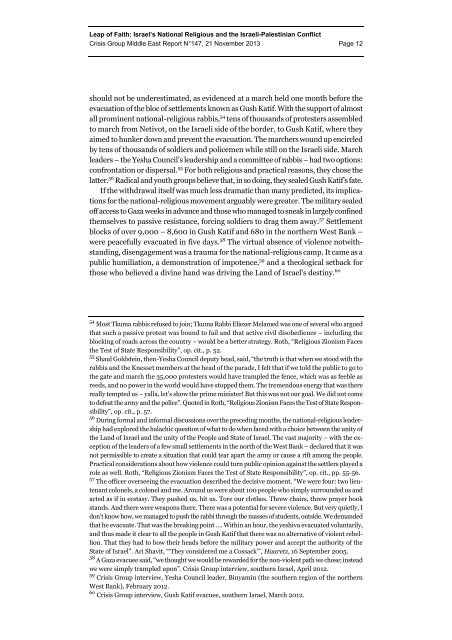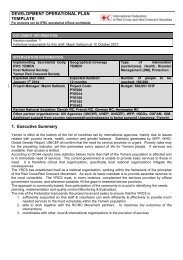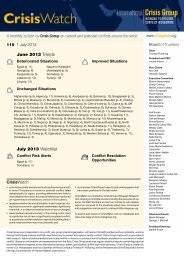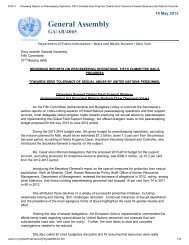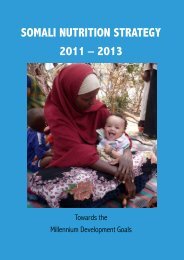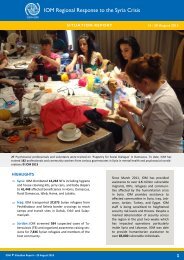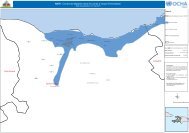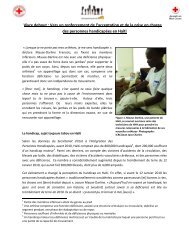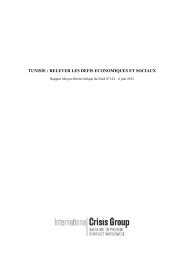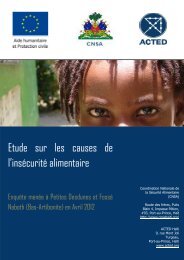Leap of Faith: Israel's National Religious and the Israeli ... - ReliefWeb
Leap of Faith: Israel's National Religious and the Israeli ... - ReliefWeb
Leap of Faith: Israel's National Religious and the Israeli ... - ReliefWeb
You also want an ePaper? Increase the reach of your titles
YUMPU automatically turns print PDFs into web optimized ePapers that Google loves.
<strong>Leap</strong> <strong>of</strong> <strong>Faith</strong>: Israel’s <strong>National</strong> <strong>Religious</strong> <strong>and</strong> <strong>the</strong> <strong>Israeli</strong>-Palestinian Conflict<br />
Crisis Group Middle East Report N°147, 21 November 2013 Page 12<br />
should not be underestimated, as evidenced at a march held one month before <strong>the</strong><br />
evacuation <strong>of</strong> <strong>the</strong> bloc <strong>of</strong> settlements known as Gush Katif. With <strong>the</strong> support <strong>of</strong> almost<br />
all prominent national-religious rabbis, 54 tens <strong>of</strong> thous<strong>and</strong>s <strong>of</strong> protesters assembled<br />
to march from Netivot, on <strong>the</strong> <strong>Israeli</strong> side <strong>of</strong> <strong>the</strong> border, to Gush Katif, where <strong>the</strong>y<br />
aimed to hunker down <strong>and</strong> prevent <strong>the</strong> evacuation. The marchers wound up encircled<br />
by tens <strong>of</strong> thous<strong>and</strong>s <strong>of</strong> soldiers <strong>and</strong> policemen while still on <strong>the</strong> <strong>Israeli</strong> side. March<br />
leaders – <strong>the</strong> Yesha Council’s leadership <strong>and</strong> a committee <strong>of</strong> rabbis – had two options:<br />
confrontation or dispersal. 55 For both religious <strong>and</strong> practical reasons, <strong>the</strong>y chose <strong>the</strong><br />
latter. 56 Radical <strong>and</strong> youth groups believe that, in so doing, <strong>the</strong>y sealed Gush Katif’s fate.<br />
If <strong>the</strong> withdrawal itself was much less dramatic than many predicted, its implications<br />
for <strong>the</strong> national-religious movement arguably were greater. The military sealed<br />
<strong>of</strong>f access to Gaza weeks in advance <strong>and</strong> those who managed to sneak in largely confined<br />
<strong>the</strong>mselves to passive resistance, forcing soldiers to drag <strong>the</strong>m away. 57 Settlement<br />
blocks <strong>of</strong> over 9,000 – 8,600 in Gush Katif <strong>and</strong> 680 in <strong>the</strong> nor<strong>the</strong>rn West Bank –<br />
were peacefully evacuated in five days. 58 The virtual absence <strong>of</strong> violence notwithst<strong>and</strong>ing,<br />
disengagement was a trauma for <strong>the</strong> national-religious camp. It came as a<br />
public humiliation, a demonstration <strong>of</strong> impotence, 59 <strong>and</strong> a <strong>the</strong>ological setback for<br />
those who believed a divine h<strong>and</strong> was driving <strong>the</strong> L<strong>and</strong> <strong>of</strong> Israel’s destiny. 60<br />
54 Most Tkuma rabbis refused to join; Tkuma Rabbi Eliezer Melamed was one <strong>of</strong> several who argued<br />
that such a passive protest was bound to fail <strong>and</strong> that active civil disobedience – including <strong>the</strong><br />
blocking <strong>of</strong> roads across <strong>the</strong> country – would be a better strategy. Roth, “<strong>Religious</strong> Zionism Faces<br />
<strong>the</strong> Test <strong>of</strong> State Responsibility”, op. cit., p. 52.<br />
55 Shaul Goldstein, <strong>the</strong>n-Yesha Council deputy head, said, “<strong>the</strong> truth is that when we stood with <strong>the</strong><br />
rabbis <strong>and</strong> <strong>the</strong> Knesset members at <strong>the</strong> head <strong>of</strong> <strong>the</strong> parade, I felt that if we told <strong>the</strong> public to go to<br />
<strong>the</strong> gate <strong>and</strong> march <strong>the</strong> 35,000 protesters would have trampled <strong>the</strong> fence, which was as feeble as<br />
reeds, <strong>and</strong> no power in <strong>the</strong> world would have stopped <strong>the</strong>m. The tremendous energy that was <strong>the</strong>re<br />
really tempted us – yalla, let’s show <strong>the</strong> prime minister! But this was not our goal. We did not come<br />
to defeat <strong>the</strong> army <strong>and</strong> <strong>the</strong> police”. Quoted in Roth, “<strong>Religious</strong> Zionism Faces <strong>the</strong> Test <strong>of</strong> State Responsibility”,<br />
op. cit., p. 57.<br />
56 During formal <strong>and</strong> informal discussions over <strong>the</strong> preceding months, <strong>the</strong> national-religious leadership<br />
had explored <strong>the</strong> halachic question <strong>of</strong> what to do when faced with a choice between <strong>the</strong> unity <strong>of</strong><br />
<strong>the</strong> L<strong>and</strong> <strong>of</strong> Israel <strong>and</strong> <strong>the</strong> unity <strong>of</strong> <strong>the</strong> People <strong>and</strong> State <strong>of</strong> Israel. The vast majority – with <strong>the</strong> exception<br />
<strong>of</strong> <strong>the</strong> leaders <strong>of</strong> a few small settlements in <strong>the</strong> north <strong>of</strong> <strong>the</strong> West Bank – declared that it was<br />
not permissible to create a situation that could tear apart <strong>the</strong> army or cause a rift among <strong>the</strong> people.<br />
Practical considerations about how violence could turn public opinion against <strong>the</strong> settlers played a<br />
role as well. Roth, “<strong>Religious</strong> Zionism Faces <strong>the</strong> Test <strong>of</strong> State Responsibility”, op. cit., pp. 55-56.<br />
57 The <strong>of</strong>ficer overseeing <strong>the</strong> evacuation described <strong>the</strong> decisive moment. “We were four: two lieutenant<br />
colonels, a colonel <strong>and</strong> me. Around us were about 100 people who simply surrounded us <strong>and</strong><br />
acted as if in ecstasy. They pushed us, hit us. Tore our clo<strong>the</strong>s. Threw chairs, threw prayer book<br />
st<strong>and</strong>s. And <strong>the</strong>re were weapons <strong>the</strong>re. There was a potential for severe violence. But very quietly, I<br />
don’t know how, we managed to push <strong>the</strong> rabbi through <strong>the</strong> masses <strong>of</strong> students, outside. We dem<strong>and</strong>ed<br />
that he evacuate. That was <strong>the</strong> breaking point …. Within an hour, <strong>the</strong> yeshiva evacuated voluntarily,<br />
<strong>and</strong> thus made it clear to all <strong>the</strong> people in Gush Katif that <strong>the</strong>re was no alternative <strong>of</strong> violent rebellion.<br />
That <strong>the</strong>y had to bow <strong>the</strong>ir heads before <strong>the</strong> military power <strong>and</strong> accept <strong>the</strong> authority <strong>of</strong> <strong>the</strong><br />
State <strong>of</strong> Israel”. Ari Shavit, “‘They considered me a Cossack’”, Haaretz, 16 September 2005.<br />
58 A Gaza evacuee said, “we thought we would be rewarded for <strong>the</strong> non-violent path we chose; instead<br />
we were simply trampled upon”. Crisis Group interview, sou<strong>the</strong>rn Israel, April 2012.<br />
59 Crisis Group interview, Yesha Council leader, Binyamin (<strong>the</strong> sou<strong>the</strong>rn region <strong>of</strong> <strong>the</strong> nor<strong>the</strong>rn<br />
West Bank), February 2012.<br />
60 Crisis Group interview, Gush Katif evacuee, sou<strong>the</strong>rn Israel, March 2012.


